пїњпїњпїњbn

Storia di Venezia,
Biblioteca
|
St. Mark's Festival in Venice
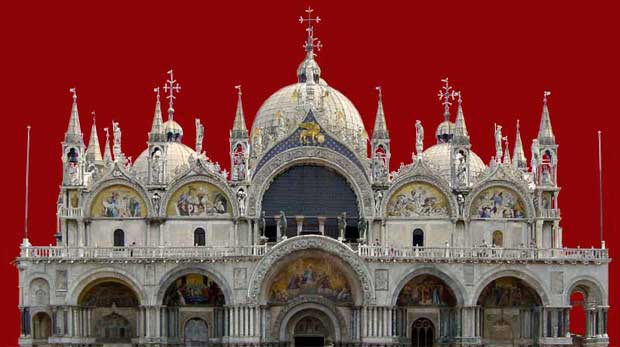 |
|---|
April the 25th in Venezia, Festival of the Blooming Rose
|
|
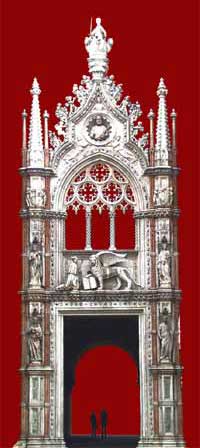 |
Venetians used to sanctify the 25th of April far before that date became the actual National Holiday of Italy liberation. April the 25th is indeed the holiday of the Patron Saint of the city, whose relic, which was on Islamic territory in Alexandria of Aegypt, was transferred in Venice in the year 828 by two legendary Venetian merchants: Buono da Malamocco and Rustico da Torcello.
The story goes that in order to subtract from the Muslims the precious body (Islam itself recognizes and venerates Christ and the Saints), the two clever merchants covered it up in a stock of pork meat, which passed through the Turkish customer without being inspected, 'cause of the disgust for that stuff imposed to the Profet believers.
We must remember that in those days (and still now, somewhere) relics were a powerful social binder; they would attract pilgrims and improve town population, a very important effect in the beginnings of Urbanism, when people were mainly living in the countryside.
Every relic was well accepted, together with the one carrying it, and the body of St. Mark was particularly welcomed in Venice, because it was believed that Saint Mark, during his life, had evangelized the inhabitants of Veneto (Venice county), becoming their Patron Saint and emblema under the shape of the winged lion.
|
Winged, armed with a sword and holding a book where, in time of peace, one could read the sentence Pax Tibi Marce Evangelista Meus (Peace to You Mark, my Evangelist); a book that was minaciously closed when the sword, instead that christianely discriminate evil from good, was red of warrior blood.
|
Today the commemoration is reduced only to the 25th of April, date of the death of the Saint, but at the times of the Serenissima people would celebrate also on the 31st of January (dies translationis corporis day of the transport of the Holy Body) and on 25th of June, the day under Doge Vitale Falier when the relic was refound in St.Mark's Basilica.
Some popular tales are associated with this Celebration.
One of these tells that, while the terrific seastorm described by Marin Sanudo was hitting the City in February 1340, a boatman that was repairing himself under the bridge de la Paja was instead invited to sail again by a Knight.
Along the journey towards the Open Sea, the boatman had to stop first in the isle of St.George Major and then in St. Nicolт in Lido to pick up two more Knights.
Once in the Open Sea, the evil pushing the water against Venice was faced and defeated by the three Knights, who were nobodyelse than the Saints Mark, George and Nicolò.
|
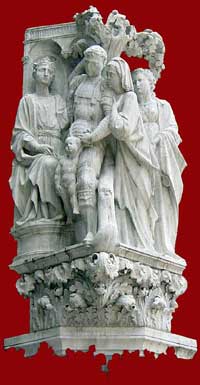
|
After defeating the evil, St. Mark committed the boatman a ring, to hand it over to Bartolomeo Gradenigo Duke of Venice at those times, to have it preserved in the St. Markіs Treasure.
In occasion of the Fest of the Patron Saint, Venetians males use to gift the bocolo (red rose bloom) to their beloved; about the origin of this gift we know two legendary hypothesis.
|
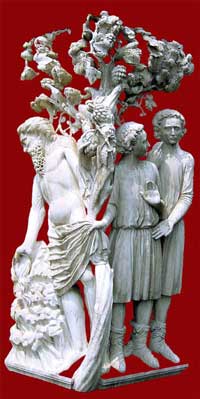 |
One is related to the story of the troubled love between the noblewoman Maria Partecipazio and Tancredi the troubadour. In the aim to overcome the social class differences, Tancredi goes to the war seeking for an army glory to high himself to the upper level of his beloved.
Unlukly, after serving as a valiant soldier the orders of Charles the Great in the War agains the Arabians in Spain, he is wounded to death, and falls over a rose bed that become red by his blood.
Dieing, Tancredi relyes on Orlando the paladin to bring a bloom from that plant to Tancredi's beloved Lady in Venice.
Orlando mantains the promise and reaches Venice the day before St. Mark Patron Day, and gives the bloom to the Lady as the last love message from her, now dead, suitor. The morning after Maria Partecipazio is found dead herself, with the red bloom sat on the heart, and since that Venetian lovers use that flower as an emblematic love pledge.
|
The other legend we know, suggests that the Tradition of the bocolo came from the rose bed growing aside the grave of St. Mark the Evangelist. The plant would has been gifted to a sailor from the Giudecca Isle called Basilio, as a prize for his cooperation in purloining the Saint Body of the Patron to Venice from Turkey.
The rosary was planted in the garden of Basilio, but became the borderline of the property divided in two parts by Basilioіs sons, when he died. The two branches of the family became later rival, with some blood too, is said, and the plants stopped flowering.
On a 25th of April, many years after, a first-sight love sparkled between a girl from one branch of Basilio's Family and a boy belonging to the other. The two youngs falled in love watching each other through the rose bed separing the properties.
|
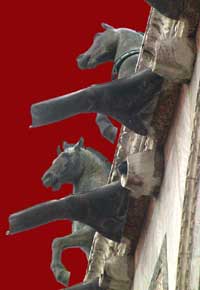 |
The rosary accompained the raising of this love with a marvellous red flowering, and the guy got one and gifted it to the girl.
In memory of this happy end love, that would had reunified the two families in peace, Venetians still now offer the red rose bloom to their beloved Ladies.
A curious and very Italian detail might be that the bocolo is also the gift that sons use to bring to their moms in that day.
Sebastiano Giorgi & Umberto Sartori
|
|
Venice Carnival Photos and hundreds other photos of Venice and of various subjects in the Image Bank of venice eXplorer .net, that you can also send to friends as free virtual postcards
All images © by Umberto Sartory
|
|
